Sainsbury's Business Environment: Types, Impacts and Analysis
VerifiedAdded on 2021/02/19
|15
|3918
|108
Report
AI Summary
This report provides an in-depth analysis of Sainsbury's business environment, examining its organizational structure as a private entity, and comparing it to public (NHS) and voluntary (Oxfam) organizations. The report details the types, purposes, legal structures, sizes, and scopes of these organizations. It explores the interrelationships between various organizational functions within Sainsbury's, such as finance, marketing, and human resources, and how these functions contribute to achieving business objectives. Furthermore, the report utilizes a PESTLE analysis to assess the positive and negative impacts of the macro environment on Sainsbury's operations, considering political, economic, social, technological, legal, and environmental factors. Finally, it conducts an internal and external analysis to identify the company's strengths and weaknesses, and explains how these relate to the external macro environment. The report concludes with a summary of the findings and a list of references.
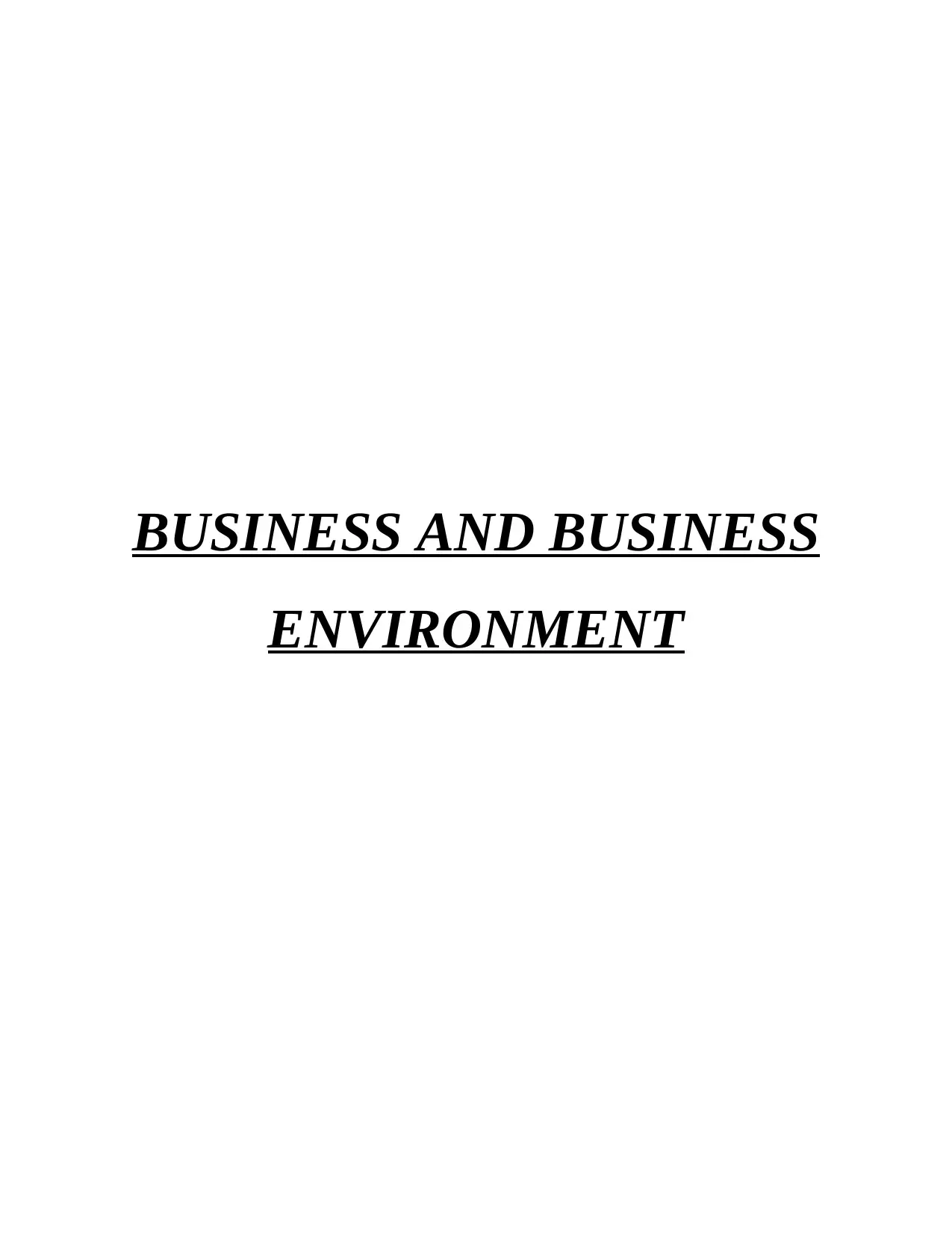
BUSINESS AND BUSINESS
ENVIRONMENT
ENVIRONMENT
Paraphrase This Document
Need a fresh take? Get an instant paraphrase of this document with our AI Paraphraser
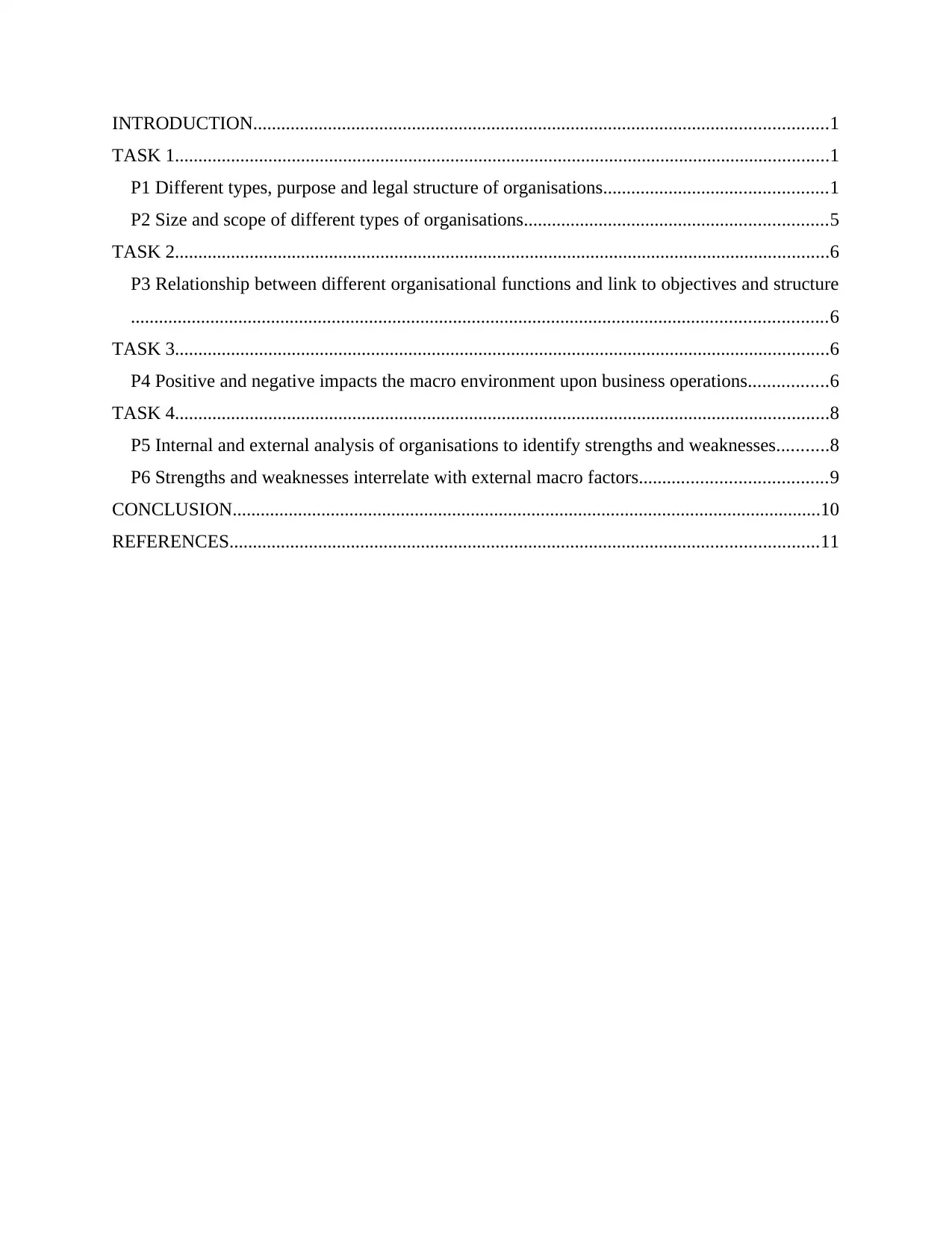
INTRODUCTION...........................................................................................................................1
TASK 1............................................................................................................................................1
P1 Different types, purpose and legal structure of organisations................................................1
P2 Size and scope of different types of organisations.................................................................5
TASK 2............................................................................................................................................6
P3 Relationship between different organisational functions and link to objectives and structure
.....................................................................................................................................................6
TASK 3............................................................................................................................................6
P4 Positive and negative impacts the macro environment upon business operations.................6
TASK 4............................................................................................................................................8
P5 Internal and external analysis of organisations to identify strengths and weaknesses...........8
P6 Strengths and weaknesses interrelate with external macro factors........................................9
CONCLUSION..............................................................................................................................10
REFERENCES..............................................................................................................................11
TASK 1............................................................................................................................................1
P1 Different types, purpose and legal structure of organisations................................................1
P2 Size and scope of different types of organisations.................................................................5
TASK 2............................................................................................................................................6
P3 Relationship between different organisational functions and link to objectives and structure
.....................................................................................................................................................6
TASK 3............................................................................................................................................6
P4 Positive and negative impacts the macro environment upon business operations.................6
TASK 4............................................................................................................................................8
P5 Internal and external analysis of organisations to identify strengths and weaknesses...........8
P6 Strengths and weaknesses interrelate with external macro factors........................................9
CONCLUSION..............................................................................................................................10
REFERENCES..............................................................................................................................11

⊘ This is a preview!⊘
Do you want full access?
Subscribe today to unlock all pages.

Trusted by 1+ million students worldwide
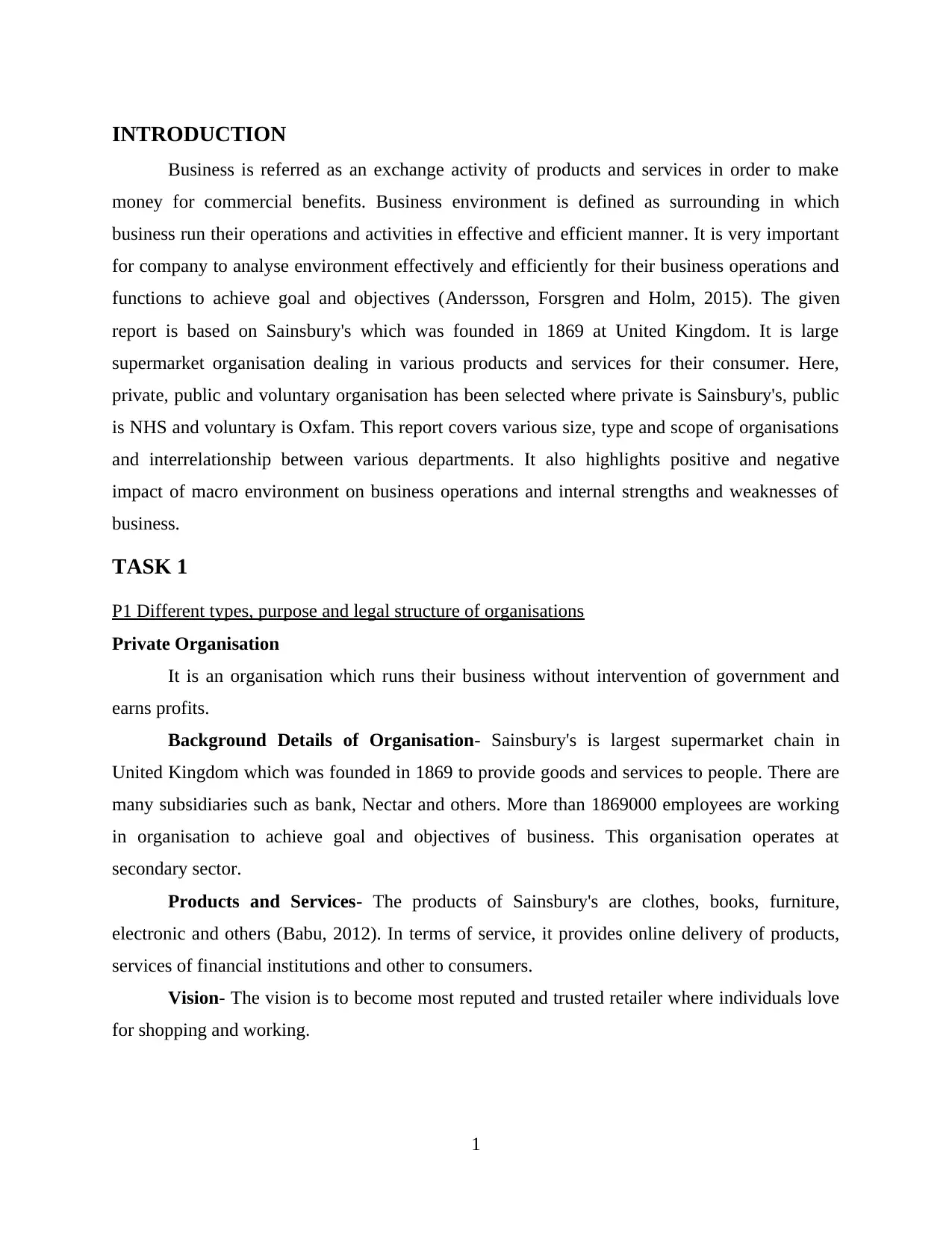
INTRODUCTION
Business is referred as an exchange activity of products and services in order to make
money for commercial benefits. Business environment is defined as surrounding in which
business run their operations and activities in effective and efficient manner. It is very important
for company to analyse environment effectively and efficiently for their business operations and
functions to achieve goal and objectives (Andersson, Forsgren and Holm, 2015). The given
report is based on Sainsbury's which was founded in 1869 at United Kingdom. It is large
supermarket organisation dealing in various products and services for their consumer. Here,
private, public and voluntary organisation has been selected where private is Sainsbury's, public
is NHS and voluntary is Oxfam. This report covers various size, type and scope of organisations
and interrelationship between various departments. It also highlights positive and negative
impact of macro environment on business operations and internal strengths and weaknesses of
business.
TASK 1
P1 Different types, purpose and legal structure of organisations
Private Organisation
It is an organisation which runs their business without intervention of government and
earns profits.
Background Details of Organisation- Sainsbury's is largest supermarket chain in
United Kingdom which was founded in 1869 to provide goods and services to people. There are
many subsidiaries such as bank, Nectar and others. More than 1869000 employees are working
in organisation to achieve goal and objectives of business. This organisation operates at
secondary sector.
Products and Services- The products of Sainsbury's are clothes, books, furniture,
electronic and others (Babu, 2012). In terms of service, it provides online delivery of products,
services of financial institutions and other to consumers.
Vision- The vision is to become most reputed and trusted retailer where individuals love
for shopping and working.
1
Business is referred as an exchange activity of products and services in order to make
money for commercial benefits. Business environment is defined as surrounding in which
business run their operations and activities in effective and efficient manner. It is very important
for company to analyse environment effectively and efficiently for their business operations and
functions to achieve goal and objectives (Andersson, Forsgren and Holm, 2015). The given
report is based on Sainsbury's which was founded in 1869 at United Kingdom. It is large
supermarket organisation dealing in various products and services for their consumer. Here,
private, public and voluntary organisation has been selected where private is Sainsbury's, public
is NHS and voluntary is Oxfam. This report covers various size, type and scope of organisations
and interrelationship between various departments. It also highlights positive and negative
impact of macro environment on business operations and internal strengths and weaknesses of
business.
TASK 1
P1 Different types, purpose and legal structure of organisations
Private Organisation
It is an organisation which runs their business without intervention of government and
earns profits.
Background Details of Organisation- Sainsbury's is largest supermarket chain in
United Kingdom which was founded in 1869 to provide goods and services to people. There are
many subsidiaries such as bank, Nectar and others. More than 1869000 employees are working
in organisation to achieve goal and objectives of business. This organisation operates at
secondary sector.
Products and Services- The products of Sainsbury's are clothes, books, furniture,
electronic and others (Babu, 2012). In terms of service, it provides online delivery of products,
services of financial institutions and other to consumers.
Vision- The vision is to become most reputed and trusted retailer where individuals love
for shopping and working.
1
Paraphrase This Document
Need a fresh take? Get an instant paraphrase of this document with our AI Paraphraser
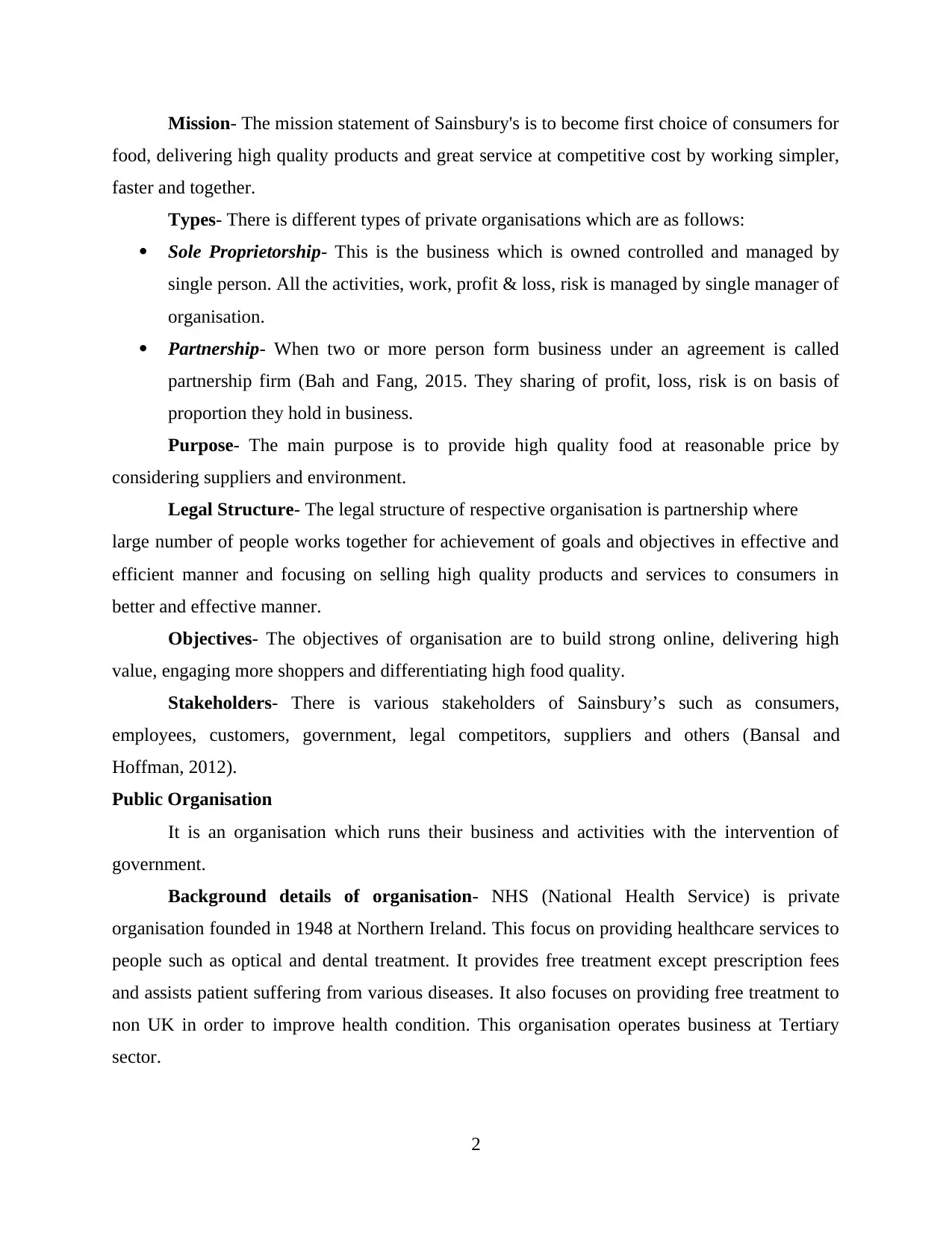
Mission- The mission statement of Sainsbury's is to become first choice of consumers for
food, delivering high quality products and great service at competitive cost by working simpler,
faster and together.
Types- There is different types of private organisations which are as follows:
Sole Proprietorship- This is the business which is owned controlled and managed by
single person. All the activities, work, profit & loss, risk is managed by single manager of
organisation.
Partnership- When two or more person form business under an agreement is called
partnership firm (Bah and Fang, 2015. They sharing of profit, loss, risk is on basis of
proportion they hold in business.
Purpose- The main purpose is to provide high quality food at reasonable price by
considering suppliers and environment.
Legal Structure- The legal structure of respective organisation is partnership where
large number of people works together for achievement of goals and objectives in effective and
efficient manner and focusing on selling high quality products and services to consumers in
better and effective manner.
Objectives- The objectives of organisation are to build strong online, delivering high
value, engaging more shoppers and differentiating high food quality.
Stakeholders- There is various stakeholders of Sainsbury’s such as consumers,
employees, customers, government, legal competitors, suppliers and others (Bansal and
Hoffman, 2012).
Public Organisation
It is an organisation which runs their business and activities with the intervention of
government.
Background details of organisation- NHS (National Health Service) is private
organisation founded in 1948 at Northern Ireland. This focus on providing healthcare services to
people such as optical and dental treatment. It provides free treatment except prescription fees
and assists patient suffering from various diseases. It also focuses on providing free treatment to
non UK in order to improve health condition. This organisation operates business at Tertiary
sector.
2
food, delivering high quality products and great service at competitive cost by working simpler,
faster and together.
Types- There is different types of private organisations which are as follows:
Sole Proprietorship- This is the business which is owned controlled and managed by
single person. All the activities, work, profit & loss, risk is managed by single manager of
organisation.
Partnership- When two or more person form business under an agreement is called
partnership firm (Bah and Fang, 2015. They sharing of profit, loss, risk is on basis of
proportion they hold in business.
Purpose- The main purpose is to provide high quality food at reasonable price by
considering suppliers and environment.
Legal Structure- The legal structure of respective organisation is partnership where
large number of people works together for achievement of goals and objectives in effective and
efficient manner and focusing on selling high quality products and services to consumers in
better and effective manner.
Objectives- The objectives of organisation are to build strong online, delivering high
value, engaging more shoppers and differentiating high food quality.
Stakeholders- There is various stakeholders of Sainsbury’s such as consumers,
employees, customers, government, legal competitors, suppliers and others (Bansal and
Hoffman, 2012).
Public Organisation
It is an organisation which runs their business and activities with the intervention of
government.
Background details of organisation- NHS (National Health Service) is private
organisation founded in 1948 at Northern Ireland. This focus on providing healthcare services to
people such as optical and dental treatment. It provides free treatment except prescription fees
and assists patient suffering from various diseases. It also focuses on providing free treatment to
non UK in order to improve health condition. This organisation operates business at Tertiary
sector.
2
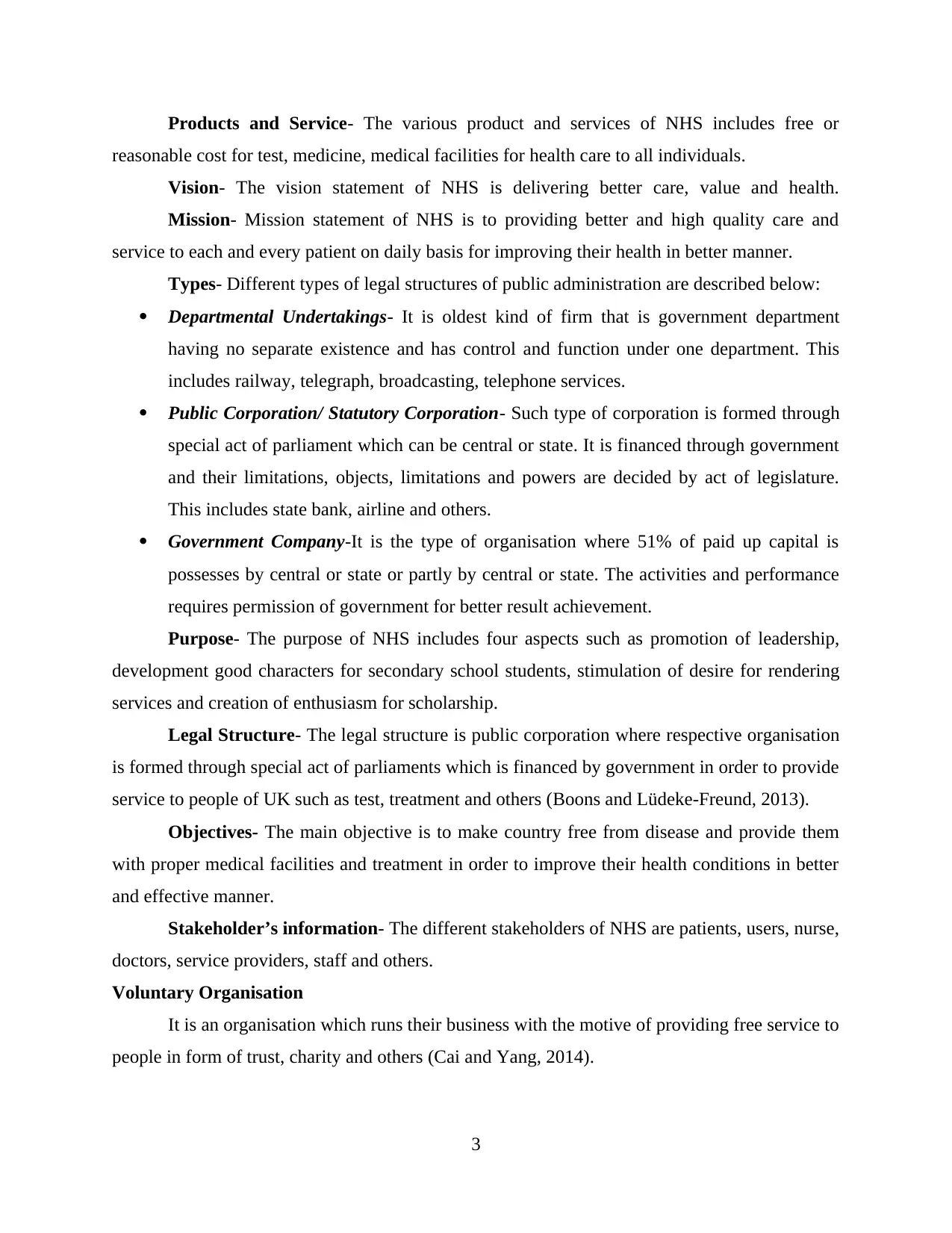
Products and Service- The various product and services of NHS includes free or
reasonable cost for test, medicine, medical facilities for health care to all individuals.
Vision- The vision statement of NHS is delivering better care, value and health.
Mission- Mission statement of NHS is to providing better and high quality care and
service to each and every patient on daily basis for improving their health in better manner.
Types- Different types of legal structures of public administration are described below:
Departmental Undertakings- It is oldest kind of firm that is government department
having no separate existence and has control and function under one department. This
includes railway, telegraph, broadcasting, telephone services.
Public Corporation/ Statutory Corporation- Such type of corporation is formed through
special act of parliament which can be central or state. It is financed through government
and their limitations, objects, limitations and powers are decided by act of legislature.
This includes state bank, airline and others.
Government Company-It is the type of organisation where 51% of paid up capital is
possesses by central or state or partly by central or state. The activities and performance
requires permission of government for better result achievement.
Purpose- The purpose of NHS includes four aspects such as promotion of leadership,
development good characters for secondary school students, stimulation of desire for rendering
services and creation of enthusiasm for scholarship.
Legal Structure- The legal structure is public corporation where respective organisation
is formed through special act of parliaments which is financed by government in order to provide
service to people of UK such as test, treatment and others (Boons and Lüdeke-Freund, 2013).
Objectives- The main objective is to make country free from disease and provide them
with proper medical facilities and treatment in order to improve their health conditions in better
and effective manner.
Stakeholder’s information- The different stakeholders of NHS are patients, users, nurse,
doctors, service providers, staff and others.
Voluntary Organisation
It is an organisation which runs their business with the motive of providing free service to
people in form of trust, charity and others (Cai and Yang, 2014).
3
reasonable cost for test, medicine, medical facilities for health care to all individuals.
Vision- The vision statement of NHS is delivering better care, value and health.
Mission- Mission statement of NHS is to providing better and high quality care and
service to each and every patient on daily basis for improving their health in better manner.
Types- Different types of legal structures of public administration are described below:
Departmental Undertakings- It is oldest kind of firm that is government department
having no separate existence and has control and function under one department. This
includes railway, telegraph, broadcasting, telephone services.
Public Corporation/ Statutory Corporation- Such type of corporation is formed through
special act of parliament which can be central or state. It is financed through government
and their limitations, objects, limitations and powers are decided by act of legislature.
This includes state bank, airline and others.
Government Company-It is the type of organisation where 51% of paid up capital is
possesses by central or state or partly by central or state. The activities and performance
requires permission of government for better result achievement.
Purpose- The purpose of NHS includes four aspects such as promotion of leadership,
development good characters for secondary school students, stimulation of desire for rendering
services and creation of enthusiasm for scholarship.
Legal Structure- The legal structure is public corporation where respective organisation
is formed through special act of parliaments which is financed by government in order to provide
service to people of UK such as test, treatment and others (Boons and Lüdeke-Freund, 2013).
Objectives- The main objective is to make country free from disease and provide them
with proper medical facilities and treatment in order to improve their health conditions in better
and effective manner.
Stakeholder’s information- The different stakeholders of NHS are patients, users, nurse,
doctors, service providers, staff and others.
Voluntary Organisation
It is an organisation which runs their business with the motive of providing free service to
people in form of trust, charity and others (Cai and Yang, 2014).
3
⊘ This is a preview!⊘
Do you want full access?
Subscribe today to unlock all pages.

Trusted by 1+ million students worldwide
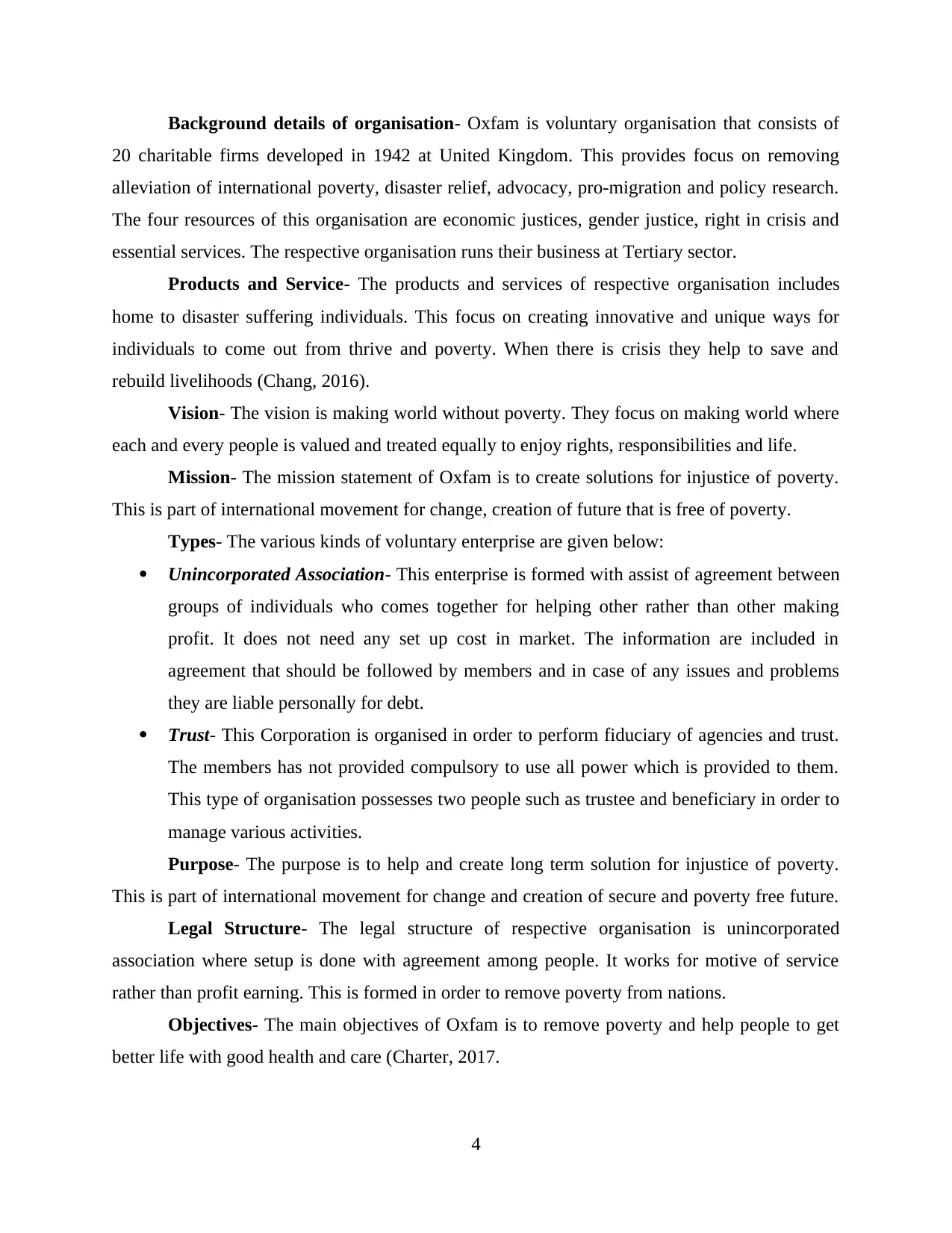
Background details of organisation- Oxfam is voluntary organisation that consists of
20 charitable firms developed in 1942 at United Kingdom. This provides focus on removing
alleviation of international poverty, disaster relief, advocacy, pro-migration and policy research.
The four resources of this organisation are economic justices, gender justice, right in crisis and
essential services. The respective organisation runs their business at Tertiary sector.
Products and Service- The products and services of respective organisation includes
home to disaster suffering individuals. This focus on creating innovative and unique ways for
individuals to come out from thrive and poverty. When there is crisis they help to save and
rebuild livelihoods (Chang, 2016).
Vision- The vision is making world without poverty. They focus on making world where
each and every people is valued and treated equally to enjoy rights, responsibilities and life.
Mission- The mission statement of Oxfam is to create solutions for injustice of poverty.
This is part of international movement for change, creation of future that is free of poverty.
Types- The various kinds of voluntary enterprise are given below:
Unincorporated Association- This enterprise is formed with assist of agreement between
groups of individuals who comes together for helping other rather than other making
profit. It does not need any set up cost in market. The information are included in
agreement that should be followed by members and in case of any issues and problems
they are liable personally for debt.
Trust- This Corporation is organised in order to perform fiduciary of agencies and trust.
The members has not provided compulsory to use all power which is provided to them.
This type of organisation possesses two people such as trustee and beneficiary in order to
manage various activities.
Purpose- The purpose is to help and create long term solution for injustice of poverty.
This is part of international movement for change and creation of secure and poverty free future.
Legal Structure- The legal structure of respective organisation is unincorporated
association where setup is done with agreement among people. It works for motive of service
rather than profit earning. This is formed in order to remove poverty from nations.
Objectives- The main objectives of Oxfam is to remove poverty and help people to get
better life with good health and care (Charter, 2017.
4
20 charitable firms developed in 1942 at United Kingdom. This provides focus on removing
alleviation of international poverty, disaster relief, advocacy, pro-migration and policy research.
The four resources of this organisation are economic justices, gender justice, right in crisis and
essential services. The respective organisation runs their business at Tertiary sector.
Products and Service- The products and services of respective organisation includes
home to disaster suffering individuals. This focus on creating innovative and unique ways for
individuals to come out from thrive and poverty. When there is crisis they help to save and
rebuild livelihoods (Chang, 2016).
Vision- The vision is making world without poverty. They focus on making world where
each and every people is valued and treated equally to enjoy rights, responsibilities and life.
Mission- The mission statement of Oxfam is to create solutions for injustice of poverty.
This is part of international movement for change, creation of future that is free of poverty.
Types- The various kinds of voluntary enterprise are given below:
Unincorporated Association- This enterprise is formed with assist of agreement between
groups of individuals who comes together for helping other rather than other making
profit. It does not need any set up cost in market. The information are included in
agreement that should be followed by members and in case of any issues and problems
they are liable personally for debt.
Trust- This Corporation is organised in order to perform fiduciary of agencies and trust.
The members has not provided compulsory to use all power which is provided to them.
This type of organisation possesses two people such as trustee and beneficiary in order to
manage various activities.
Purpose- The purpose is to help and create long term solution for injustice of poverty.
This is part of international movement for change and creation of secure and poverty free future.
Legal Structure- The legal structure of respective organisation is unincorporated
association where setup is done with agreement among people. It works for motive of service
rather than profit earning. This is formed in order to remove poverty from nations.
Objectives- The main objectives of Oxfam is to remove poverty and help people to get
better life with good health and care (Charter, 2017.
4
Paraphrase This Document
Need a fresh take? Get an instant paraphrase of this document with our AI Paraphraser
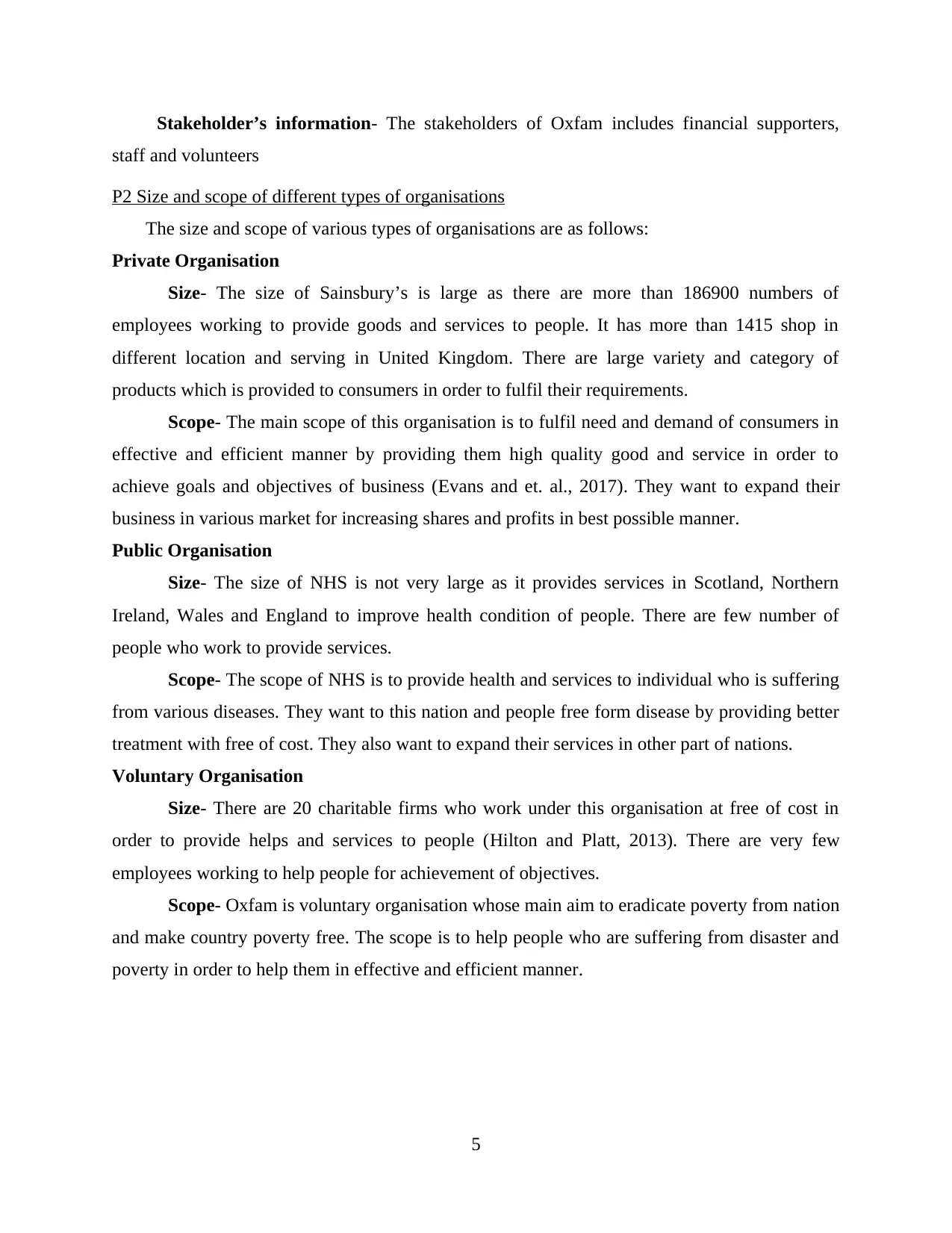
Stakeholder’s information- The stakeholders of Oxfam includes financial supporters,
staff and volunteers
P2 Size and scope of different types of organisations
The size and scope of various types of organisations are as follows:
Private Organisation
Size- The size of Sainsbury’s is large as there are more than 186900 numbers of
employees working to provide goods and services to people. It has more than 1415 shop in
different location and serving in United Kingdom. There are large variety and category of
products which is provided to consumers in order to fulfil their requirements.
Scope- The main scope of this organisation is to fulfil need and demand of consumers in
effective and efficient manner by providing them high quality good and service in order to
achieve goals and objectives of business (Evans and et. al., 2017). They want to expand their
business in various market for increasing shares and profits in best possible manner.
Public Organisation
Size- The size of NHS is not very large as it provides services in Scotland, Northern
Ireland, Wales and England to improve health condition of people. There are few number of
people who work to provide services.
Scope- The scope of NHS is to provide health and services to individual who is suffering
from various diseases. They want to this nation and people free form disease by providing better
treatment with free of cost. They also want to expand their services in other part of nations.
Voluntary Organisation
Size- There are 20 charitable firms who work under this organisation at free of cost in
order to provide helps and services to people (Hilton and Platt, 2013). There are very few
employees working to help people for achievement of objectives.
Scope- Oxfam is voluntary organisation whose main aim to eradicate poverty from nation
and make country poverty free. The scope is to help people who are suffering from disaster and
poverty in order to help them in effective and efficient manner.
5
staff and volunteers
P2 Size and scope of different types of organisations
The size and scope of various types of organisations are as follows:
Private Organisation
Size- The size of Sainsbury’s is large as there are more than 186900 numbers of
employees working to provide goods and services to people. It has more than 1415 shop in
different location and serving in United Kingdom. There are large variety and category of
products which is provided to consumers in order to fulfil their requirements.
Scope- The main scope of this organisation is to fulfil need and demand of consumers in
effective and efficient manner by providing them high quality good and service in order to
achieve goals and objectives of business (Evans and et. al., 2017). They want to expand their
business in various market for increasing shares and profits in best possible manner.
Public Organisation
Size- The size of NHS is not very large as it provides services in Scotland, Northern
Ireland, Wales and England to improve health condition of people. There are few number of
people who work to provide services.
Scope- The scope of NHS is to provide health and services to individual who is suffering
from various diseases. They want to this nation and people free form disease by providing better
treatment with free of cost. They also want to expand their services in other part of nations.
Voluntary Organisation
Size- There are 20 charitable firms who work under this organisation at free of cost in
order to provide helps and services to people (Hilton and Platt, 2013). There are very few
employees working to help people for achievement of objectives.
Scope- Oxfam is voluntary organisation whose main aim to eradicate poverty from nation
and make country poverty free. The scope is to help people who are suffering from disaster and
poverty in order to help them in effective and efficient manner.
5
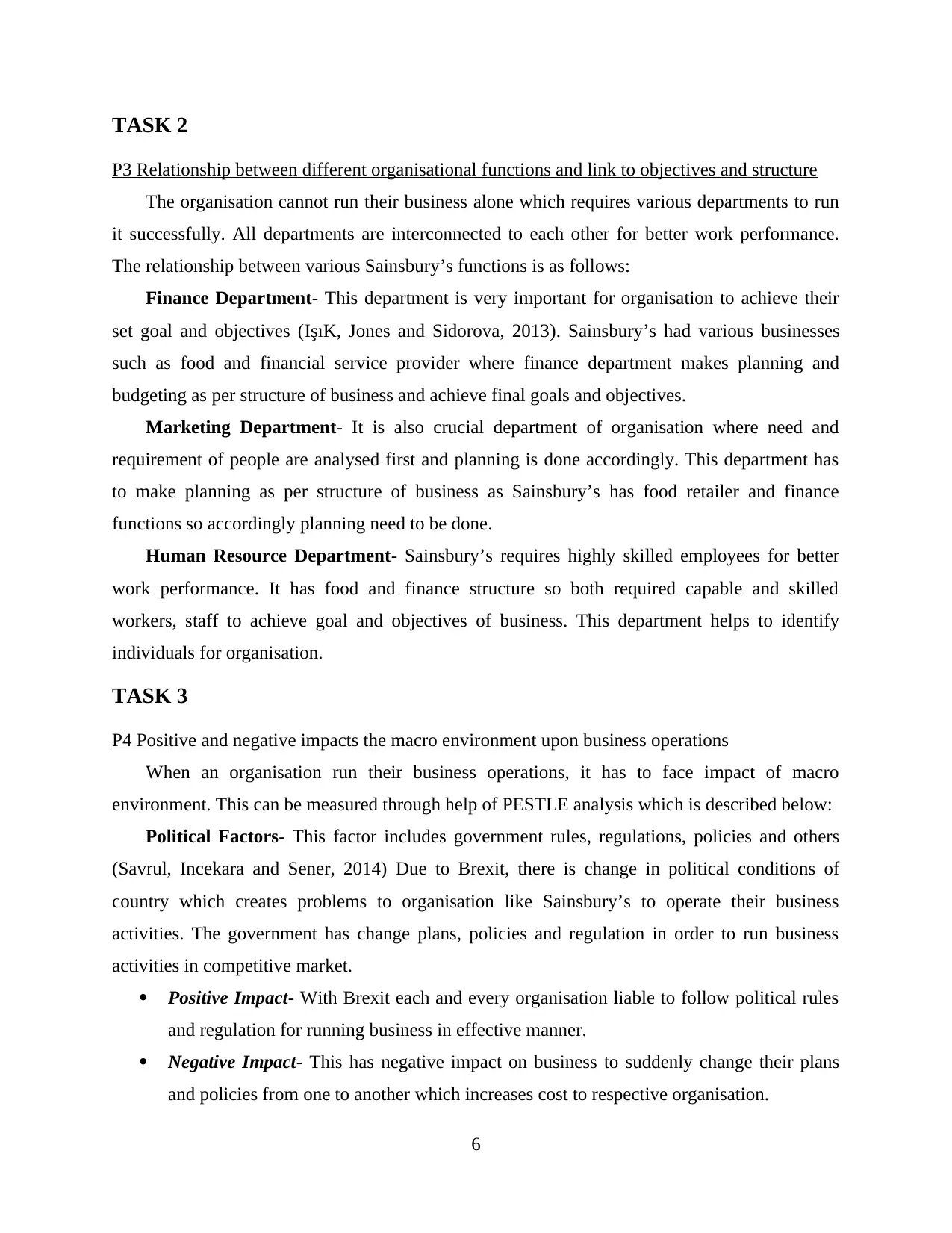
TASK 2
P3 Relationship between different organisational functions and link to objectives and structure
The organisation cannot run their business alone which requires various departments to run
it successfully. All departments are interconnected to each other for better work performance.
The relationship between various Sainsbury’s functions is as follows:
Finance Department- This department is very important for organisation to achieve their
set goal and objectives (IşıK, Jones and Sidorova, 2013). Sainsbury’s had various businesses
such as food and financial service provider where finance department makes planning and
budgeting as per structure of business and achieve final goals and objectives.
Marketing Department- It is also crucial department of organisation where need and
requirement of people are analysed first and planning is done accordingly. This department has
to make planning as per structure of business as Sainsbury’s has food retailer and finance
functions so accordingly planning need to be done.
Human Resource Department- Sainsbury’s requires highly skilled employees for better
work performance. It has food and finance structure so both required capable and skilled
workers, staff to achieve goal and objectives of business. This department helps to identify
individuals for organisation.
TASK 3
P4 Positive and negative impacts the macro environment upon business operations
When an organisation run their business operations, it has to face impact of macro
environment. This can be measured through help of PESTLE analysis which is described below:
Political Factors- This factor includes government rules, regulations, policies and others
(Savrul, Incekara and Sener, 2014) Due to Brexit, there is change in political conditions of
country which creates problems to organisation like Sainsbury’s to operate their business
activities. The government has change plans, policies and regulation in order to run business
activities in competitive market.
Positive Impact- With Brexit each and every organisation liable to follow political rules
and regulation for running business in effective manner.
Negative Impact- This has negative impact on business to suddenly change their plans
and policies from one to another which increases cost to respective organisation.
6
P3 Relationship between different organisational functions and link to objectives and structure
The organisation cannot run their business alone which requires various departments to run
it successfully. All departments are interconnected to each other for better work performance.
The relationship between various Sainsbury’s functions is as follows:
Finance Department- This department is very important for organisation to achieve their
set goal and objectives (IşıK, Jones and Sidorova, 2013). Sainsbury’s had various businesses
such as food and financial service provider where finance department makes planning and
budgeting as per structure of business and achieve final goals and objectives.
Marketing Department- It is also crucial department of organisation where need and
requirement of people are analysed first and planning is done accordingly. This department has
to make planning as per structure of business as Sainsbury’s has food retailer and finance
functions so accordingly planning need to be done.
Human Resource Department- Sainsbury’s requires highly skilled employees for better
work performance. It has food and finance structure so both required capable and skilled
workers, staff to achieve goal and objectives of business. This department helps to identify
individuals for organisation.
TASK 3
P4 Positive and negative impacts the macro environment upon business operations
When an organisation run their business operations, it has to face impact of macro
environment. This can be measured through help of PESTLE analysis which is described below:
Political Factors- This factor includes government rules, regulations, policies and others
(Savrul, Incekara and Sener, 2014) Due to Brexit, there is change in political conditions of
country which creates problems to organisation like Sainsbury’s to operate their business
activities. The government has change plans, policies and regulation in order to run business
activities in competitive market.
Positive Impact- With Brexit each and every organisation liable to follow political rules
and regulation for running business in effective manner.
Negative Impact- This has negative impact on business to suddenly change their plans
and policies from one to another which increases cost to respective organisation.
6
⊘ This is a preview!⊘
Do you want full access?
Subscribe today to unlock all pages.

Trusted by 1+ million students worldwide
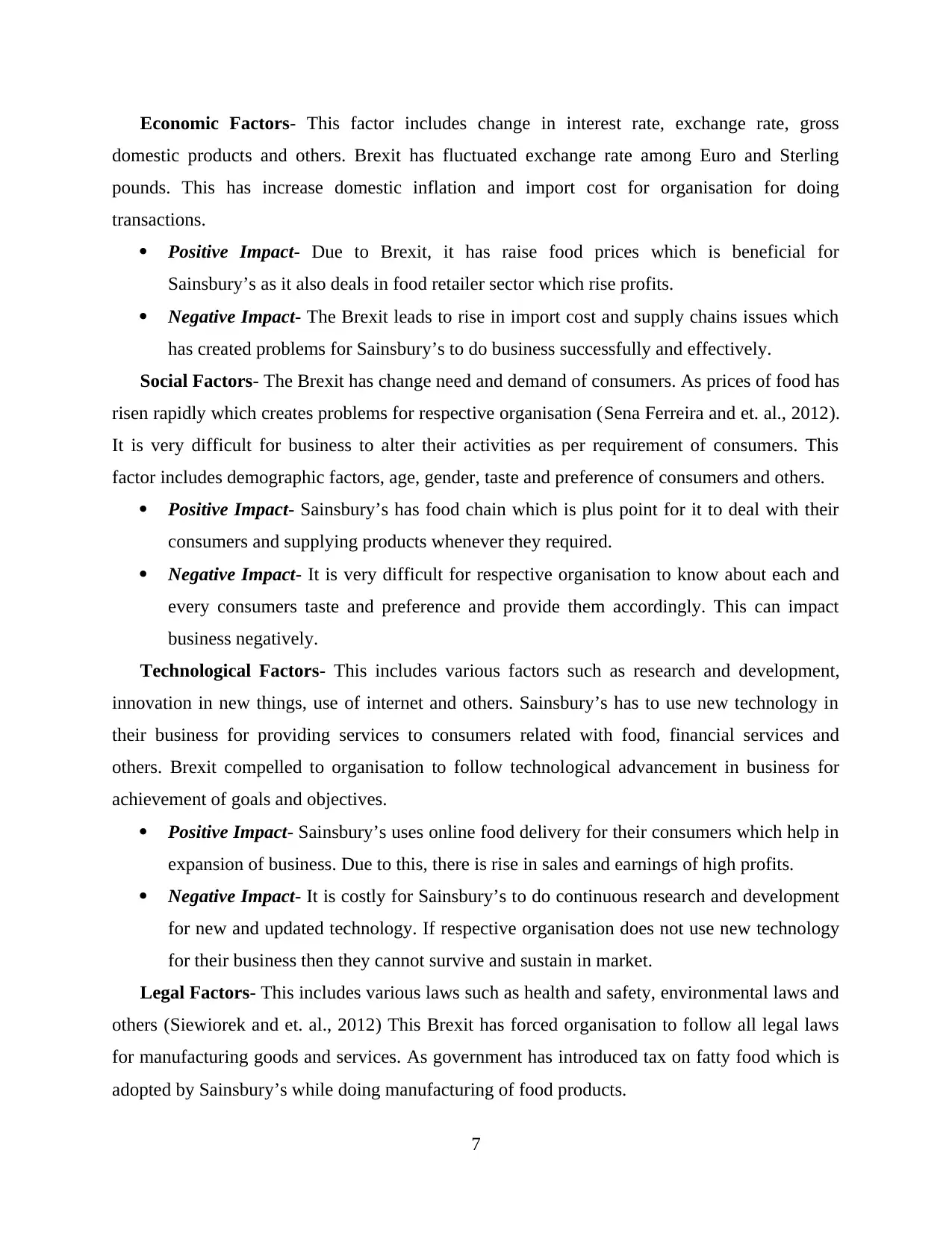
Economic Factors- This factor includes change in interest rate, exchange rate, gross
domestic products and others. Brexit has fluctuated exchange rate among Euro and Sterling
pounds. This has increase domestic inflation and import cost for organisation for doing
transactions.
Positive Impact- Due to Brexit, it has raise food prices which is beneficial for
Sainsbury’s as it also deals in food retailer sector which rise profits.
Negative Impact- The Brexit leads to rise in import cost and supply chains issues which
has created problems for Sainsbury’s to do business successfully and effectively.
Social Factors- The Brexit has change need and demand of consumers. As prices of food has
risen rapidly which creates problems for respective organisation (Sena Ferreira and et. al., 2012).
It is very difficult for business to alter their activities as per requirement of consumers. This
factor includes demographic factors, age, gender, taste and preference of consumers and others.
Positive Impact- Sainsbury’s has food chain which is plus point for it to deal with their
consumers and supplying products whenever they required.
Negative Impact- It is very difficult for respective organisation to know about each and
every consumers taste and preference and provide them accordingly. This can impact
business negatively.
Technological Factors- This includes various factors such as research and development,
innovation in new things, use of internet and others. Sainsbury’s has to use new technology in
their business for providing services to consumers related with food, financial services and
others. Brexit compelled to organisation to follow technological advancement in business for
achievement of goals and objectives.
Positive Impact- Sainsbury’s uses online food delivery for their consumers which help in
expansion of business. Due to this, there is rise in sales and earnings of high profits.
Negative Impact- It is costly for Sainsbury’s to do continuous research and development
for new and updated technology. If respective organisation does not use new technology
for their business then they cannot survive and sustain in market.
Legal Factors- This includes various laws such as health and safety, environmental laws and
others (Siewiorek and et. al., 2012) This Brexit has forced organisation to follow all legal laws
for manufacturing goods and services. As government has introduced tax on fatty food which is
adopted by Sainsbury’s while doing manufacturing of food products.
7
domestic products and others. Brexit has fluctuated exchange rate among Euro and Sterling
pounds. This has increase domestic inflation and import cost for organisation for doing
transactions.
Positive Impact- Due to Brexit, it has raise food prices which is beneficial for
Sainsbury’s as it also deals in food retailer sector which rise profits.
Negative Impact- The Brexit leads to rise in import cost and supply chains issues which
has created problems for Sainsbury’s to do business successfully and effectively.
Social Factors- The Brexit has change need and demand of consumers. As prices of food has
risen rapidly which creates problems for respective organisation (Sena Ferreira and et. al., 2012).
It is very difficult for business to alter their activities as per requirement of consumers. This
factor includes demographic factors, age, gender, taste and preference of consumers and others.
Positive Impact- Sainsbury’s has food chain which is plus point for it to deal with their
consumers and supplying products whenever they required.
Negative Impact- It is very difficult for respective organisation to know about each and
every consumers taste and preference and provide them accordingly. This can impact
business negatively.
Technological Factors- This includes various factors such as research and development,
innovation in new things, use of internet and others. Sainsbury’s has to use new technology in
their business for providing services to consumers related with food, financial services and
others. Brexit compelled to organisation to follow technological advancement in business for
achievement of goals and objectives.
Positive Impact- Sainsbury’s uses online food delivery for their consumers which help in
expansion of business. Due to this, there is rise in sales and earnings of high profits.
Negative Impact- It is costly for Sainsbury’s to do continuous research and development
for new and updated technology. If respective organisation does not use new technology
for their business then they cannot survive and sustain in market.
Legal Factors- This includes various laws such as health and safety, environmental laws and
others (Siewiorek and et. al., 2012) This Brexit has forced organisation to follow all legal laws
for manufacturing goods and services. As government has introduced tax on fatty food which is
adopted by Sainsbury’s while doing manufacturing of food products.
7
Paraphrase This Document
Need a fresh take? Get an instant paraphrase of this document with our AI Paraphraser
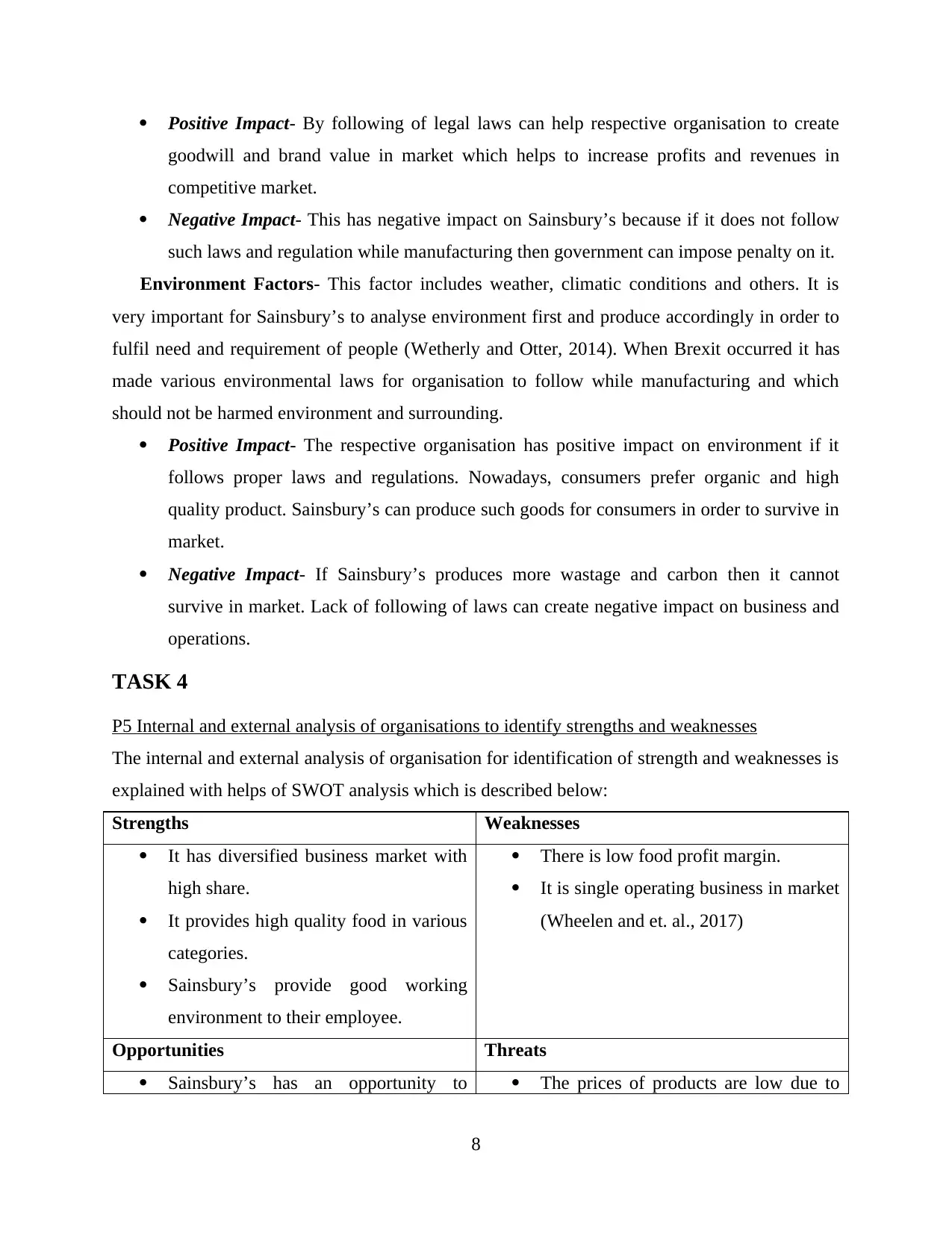
Positive Impact- By following of legal laws can help respective organisation to create
goodwill and brand value in market which helps to increase profits and revenues in
competitive market.
Negative Impact- This has negative impact on Sainsbury’s because if it does not follow
such laws and regulation while manufacturing then government can impose penalty on it.
Environment Factors- This factor includes weather, climatic conditions and others. It is
very important for Sainsbury’s to analyse environment first and produce accordingly in order to
fulfil need and requirement of people (Wetherly and Otter, 2014). When Brexit occurred it has
made various environmental laws for organisation to follow while manufacturing and which
should not be harmed environment and surrounding.
Positive Impact- The respective organisation has positive impact on environment if it
follows proper laws and regulations. Nowadays, consumers prefer organic and high
quality product. Sainsbury’s can produce such goods for consumers in order to survive in
market.
Negative Impact- If Sainsbury’s produces more wastage and carbon then it cannot
survive in market. Lack of following of laws can create negative impact on business and
operations.
TASK 4
P5 Internal and external analysis of organisations to identify strengths and weaknesses
The internal and external analysis of organisation for identification of strength and weaknesses is
explained with helps of SWOT analysis which is described below:
Strengths Weaknesses
It has diversified business market with
high share.
It provides high quality food in various
categories.
Sainsbury’s provide good working
environment to their employee.
There is low food profit margin.
It is single operating business in market
(Wheelen and et. al., 2017)
Opportunities Threats
Sainsbury’s has an opportunity to The prices of products are low due to
8
goodwill and brand value in market which helps to increase profits and revenues in
competitive market.
Negative Impact- This has negative impact on Sainsbury’s because if it does not follow
such laws and regulation while manufacturing then government can impose penalty on it.
Environment Factors- This factor includes weather, climatic conditions and others. It is
very important for Sainsbury’s to analyse environment first and produce accordingly in order to
fulfil need and requirement of people (Wetherly and Otter, 2014). When Brexit occurred it has
made various environmental laws for organisation to follow while manufacturing and which
should not be harmed environment and surrounding.
Positive Impact- The respective organisation has positive impact on environment if it
follows proper laws and regulations. Nowadays, consumers prefer organic and high
quality product. Sainsbury’s can produce such goods for consumers in order to survive in
market.
Negative Impact- If Sainsbury’s produces more wastage and carbon then it cannot
survive in market. Lack of following of laws can create negative impact on business and
operations.
TASK 4
P5 Internal and external analysis of organisations to identify strengths and weaknesses
The internal and external analysis of organisation for identification of strength and weaknesses is
explained with helps of SWOT analysis which is described below:
Strengths Weaknesses
It has diversified business market with
high share.
It provides high quality food in various
categories.
Sainsbury’s provide good working
environment to their employee.
There is low food profit margin.
It is single operating business in market
(Wheelen and et. al., 2017)
Opportunities Threats
Sainsbury’s has an opportunity to The prices of products are low due to
8
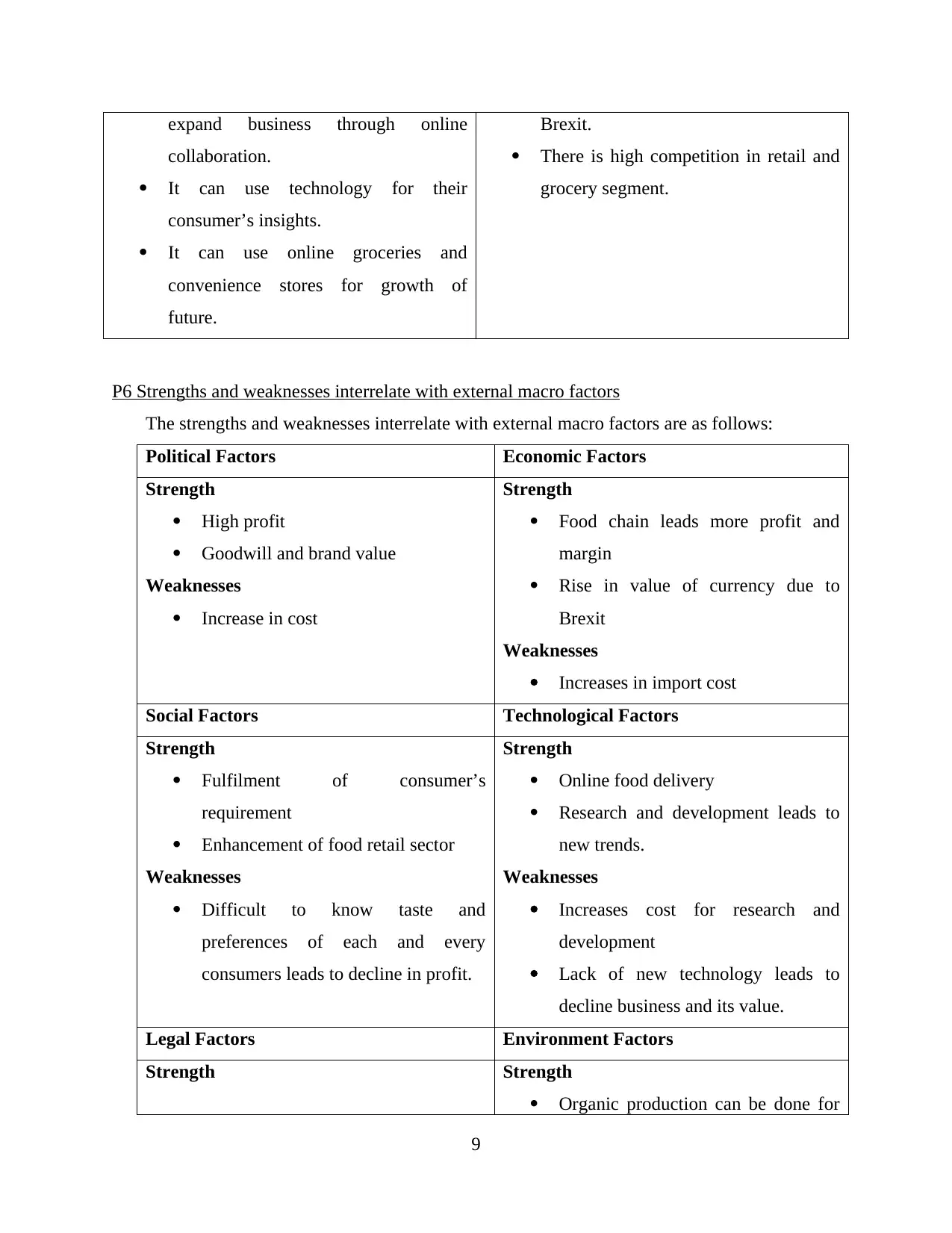
expand business through online
collaboration.
It can use technology for their
consumer’s insights.
It can use online groceries and
convenience stores for growth of
future.
Brexit.
There is high competition in retail and
grocery segment.
P6 Strengths and weaknesses interrelate with external macro factors
The strengths and weaknesses interrelate with external macro factors are as follows:
Political Factors Economic Factors
Strength
High profit
Goodwill and brand value
Weaknesses
Increase in cost
Strength
Food chain leads more profit and
margin
Rise in value of currency due to
Brexit
Weaknesses
Increases in import cost
Social Factors Technological Factors
Strength
Fulfilment of consumer’s
requirement
Enhancement of food retail sector
Weaknesses
Difficult to know taste and
preferences of each and every
consumers leads to decline in profit.
Strength
Online food delivery
Research and development leads to
new trends.
Weaknesses
Increases cost for research and
development
Lack of new technology leads to
decline business and its value.
Legal Factors Environment Factors
Strength Strength
Organic production can be done for
9
collaboration.
It can use technology for their
consumer’s insights.
It can use online groceries and
convenience stores for growth of
future.
Brexit.
There is high competition in retail and
grocery segment.
P6 Strengths and weaknesses interrelate with external macro factors
The strengths and weaknesses interrelate with external macro factors are as follows:
Political Factors Economic Factors
Strength
High profit
Goodwill and brand value
Weaknesses
Increase in cost
Strength
Food chain leads more profit and
margin
Rise in value of currency due to
Brexit
Weaknesses
Increases in import cost
Social Factors Technological Factors
Strength
Fulfilment of consumer’s
requirement
Enhancement of food retail sector
Weaknesses
Difficult to know taste and
preferences of each and every
consumers leads to decline in profit.
Strength
Online food delivery
Research and development leads to
new trends.
Weaknesses
Increases cost for research and
development
Lack of new technology leads to
decline business and its value.
Legal Factors Environment Factors
Strength Strength
Organic production can be done for
9
⊘ This is a preview!⊘
Do you want full access?
Subscribe today to unlock all pages.

Trusted by 1+ million students worldwide
1 out of 15
Related Documents
Your All-in-One AI-Powered Toolkit for Academic Success.
+13062052269
info@desklib.com
Available 24*7 on WhatsApp / Email
![[object Object]](/_next/static/media/star-bottom.7253800d.svg)
Unlock your academic potential
Copyright © 2020–2025 A2Z Services. All Rights Reserved. Developed and managed by ZUCOL.





